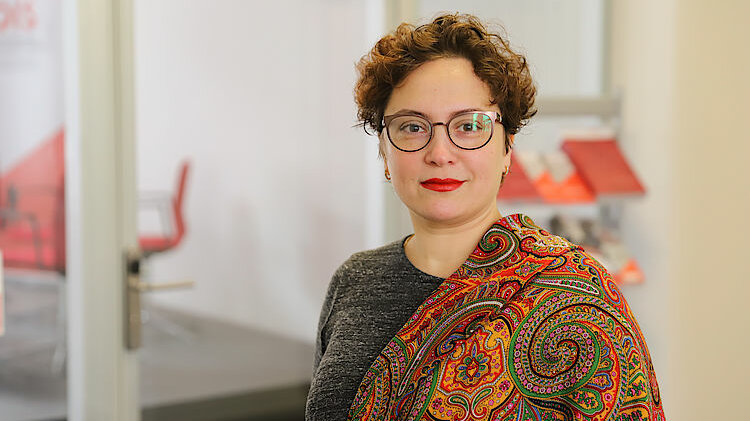“Every conflict has an effect on migration patterns”
Since the end of the Soviet Union, migration management has become a tool for staking out zones of geopolitical influence. In her new book “Migration as a (Geo-)Political Challenge in the Post-Soviet Space: Border Regimes, Policy Choices, Visa Agendas”, Olga Gulina analyses migration policy trends in the post-Soviet space and their impacts in the region and beyond. In this interview with ZOiS, she offers some insights into her migration research.

Tell us about your book: what is it about, and what new ground does it cover?
The book describes the migration pathways taken by residents of the newly independent states since the collapse of the Soviet Union in 1991, and shows how migration management has become a geopolitical tool in the post-Soviet space. It looks for answers to questions such as these: is migration an opportunity or a challenge in these countries? Can inhabitants of the newly independent states, its human capital, safeguard stability through prosperity, security and peace in the post-Soviet space, and if so, how?
Talking of human capital, what role does migration play as an economic factor in the post-Soviet space?
Residents of the newly independent states is the number one export from Eurasia today. The former Soviet states can be divided into two groups: migrant-sending countries and migrant-receiving countries, depending on whether more people leave a country or come in it. Nowadays, migrant-sending countries include Ukraine, Moldova, Georgia, Armenia, Uzbekistan, Tajikistan, Kyrgyzstan and Turkmenistan. In Uzbekistan, there are around seven emigrants for every immigrant, while in Tajikistan, the figure rises to just under 600 emigrants, which is staggering. The second group – countries of migrant destination – consists of just two states: Russia and Kazakhstan. For every emigrant, there were 12 immigrants into Russia and 44 into Kazakhstan in 2013.
The independent successor states to the Soviet Union, particularly Ukraine, Moldova, Georgia, Armenia, Tajikistan and Kyrgyzstan, rely on remittances – money transfers from migrants working and living abroad. These remittances help to ease social tensions within migrant home-based countries. However, most of the cash is swallowed up by consumer goods and loans; this is because in almost every post-Soviet state, the government relies on migration as an economic factor and does very little in terms of providing tax relief to boost good employment, supporting business start-ups or developing a more viable local labour market.
In your book, you argue that migration management is being used as a geopolitical tool. Could you explain?
The geopolitical games around immigration and out-migration by residents of the newly independent states have a considerable influence on political, economic and social conditions in these countries. There are many examples that bear this out. In March 2017, Russian President Vladimir Putin and Tajikistan’s President Emomali Rahmon agreed an amnesty lifting the travel bans on Tajik labour migrants, allowing them to enter the Russian Federation again. This agreement caused a subsequent flare of enthusiasm among the Tajiks towards their ruling elites and Rahmon’s presidency for the next years. Another example is the dual citizenship agreement between Russia and Moldova. The legalisation of Moldovan migrants, who had previously violated Russia’s migration laws, was the main slogans of the party led by Moldova’s president Igor Dodon at the parliamentary election in 2018.
How have the war in Eastern Ukraine since 2014 and other conflicts in the region impacted on migration movements?
Every conflict has an effect on migration patterns human movements and its management ruled by states. The war in Eastern Ukraine has certainly affected migration patterns in Eurasia. The target destinations of migrants coming from Ukraine changed for the first time in almost 25 years: in 2014, more Ukrainians travelled west in search of work (to Poland, the United Kingdom or the Czech Republic, for example) than to Russia. The conflict had an impact on migration movements within Russia: migrants from the Central Asian countries were leaving Russia because the country’s economy was weakened by the international sanctions.
In addition to the Russia-Ukraine conflict, there are currently four other frozen conflicts in the post-Soviet region: in South Ossetia and Abkhazia, Nagorno-Karabakh and Transnistria. Each conflict has its own history, dynamics and starting points, but the victims are always the same: it is the civilians and ordinary citizens who suffer.
Each frozen conflict in the post-Soviet space affects people’s mobility. After Russia officially recognised Abkhazia and South Ossetia, Georgia unilaterally lifted up the visa requirement for residents of Russia’s problematical regions in North Caucasus. Russia retaliated by tightening up the visa application process for all citizens of Georgia. It’s a bureaucratic procedure which has become increasingly complicated, and more and more visa applications are being rejected. Currently, Georgian citizens can only apply for a Russian visa at the Russian Federation Interests Section at the Embassy of Switzerland in Tbilisi.
In the European Union, migration from the post-Soviet space is less of an issue than migration from other regions. How important is it?
At present, migration dynamics in the newly independent states is not attracting much attention, however this could change at any time. The relatively bloodless collapse of the Soviet Union triggered a wave of ethnic migration to Germany and Poland, but did not pose any threat to Europe at that time. Today, any unrest in modern Eurasia could easily reverberate in the EU member states because of the potentially very different nature of modern migration outflows from the newly independent states to Europe.
The interview was conducted by Yvonne Troll, communications coordinator at ZOiS.
Olga Gulina has a PhD in migration law and is the founder and director of RUSMPI UG – Institute on Migration Policy in Berlin.